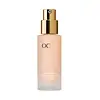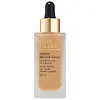Ogee Complexion Perfecting Tinted Serum Versus Estée Lauder Futurist SkinTint Serum Foundation With Botanical Oil Infusion SPF 20
What's inside
What's inside
 Key Ingredients
Key Ingredients

 Benefits
Benefits

 Concerns
Concerns

 Ingredients Side-by-side
Ingredients Side-by-side

Aloe Barbadensis Leaf Juice
Skin ConditioningEthyl Palmate
EmollientGlycerin
HumectantPolyglyceryl-4 Diisostearate/Polyhydroxystearate/Sebacate
EmulsifyingSimmondsia Chinensis Seed Oil
EmollientPropanediol
SolventBellis Perennis Flower Extract
Skin ConditioningPolyglyceryl-3 Diisostearate
EmulsifyingMicrocrystalline Cellulose
AbsorbentCopaifera Officinalis Resin
MaskingCoco-Caprylate/Caprate
EmollientMagnesium Sulfate
Glyceryl Oleate
EmollientPolyglyceryl-2 Dipolyhydroxystearate
Skin ConditioningTrihydroxystearin
Skin ConditioningTriheptanoin
Skin ConditioningCaprylyl Glyceryl Ether
CleansingPhysalis Pubescens Fruit Juice
Skin ConditioningTetrahexyldecyl Ascorbate
AntioxidantPhenylpropanol
MaskingCaprylic/Capric Triglyceride
MaskingXanthan Gum
EmulsifyingC9-12 Alkane
SolventDilinoleic Acid/Butanediol Copolymer
Hydrogenated Castor Oil/Dimer Dilinoleic Acid Copolymer
Carapa Guaianensis Seed Oil
Skin ConditioningRaspberry Ketone
MaskingEuterpe Oleracea Fruit Oil
Skin ConditioningCaprylhydroxamic Acid
Hydrogenated Lecithin
EmulsifyingAloe Barbadensis Leaf Juice Powder
Skin ConditioningCellulose
AbsorbentRosmarinus Officinalis Leaf Extract
AntimicrobialArginine
MaskingPhenethyl Alcohol
MaskingCastor Oil/Ipdi Copolymer
Magnesium Chloride
Mica
Cosmetic ColorantTocopherol
AntioxidantSodium Chloride
MaskingPotassium Chloride
Potassium Phosphate
BufferingDisodium Phosphate
BufferingLecithin
EmollientAscorbyl Palmitate
AntioxidantHydrogenated Palm Glycerides Citrate
EmollientCalcium Chloride
AstringentCI 77891
Cosmetic ColorantCI 77491
Cosmetic ColorantCI 77492
Cosmetic ColorantCI 77499
Cosmetic ColorantAloe Barbadensis Leaf Juice, Ethyl Palmate, Glycerin, Polyglyceryl-4 Diisostearate/Polyhydroxystearate/Sebacate, Simmondsia Chinensis Seed Oil, Propanediol, Bellis Perennis Flower Extract, Polyglyceryl-3 Diisostearate, Microcrystalline Cellulose, Copaifera Officinalis Resin, Coco-Caprylate/Caprate, Magnesium Sulfate, Glyceryl Oleate, Polyglyceryl-2 Dipolyhydroxystearate, Trihydroxystearin, Triheptanoin, Caprylyl Glyceryl Ether, Physalis Pubescens Fruit Juice, Tetrahexyldecyl Ascorbate, Phenylpropanol, Caprylic/Capric Triglyceride, Xanthan Gum, C9-12 Alkane, Dilinoleic Acid/Butanediol Copolymer, Hydrogenated Castor Oil/Dimer Dilinoleic Acid Copolymer, Carapa Guaianensis Seed Oil, Raspberry Ketone, Euterpe Oleracea Fruit Oil, Caprylhydroxamic Acid, Hydrogenated Lecithin, Aloe Barbadensis Leaf Juice Powder, Cellulose, Rosmarinus Officinalis Leaf Extract, Arginine, Phenethyl Alcohol, Castor Oil/Ipdi Copolymer, Magnesium Chloride, Mica, Tocopherol, Sodium Chloride, Potassium Chloride, Potassium Phosphate, Disodium Phosphate, Lecithin, Ascorbyl Palmitate, Hydrogenated Palm Glycerides Citrate, Calcium Chloride, CI 77891, CI 77491, CI 77492, CI 77499
Ethylhexyl Methoxycinnamate 6.7%
UV AbsorberEthylhexyl Salicylate 4.5%
UV AbsorberZinc Oxide 6.8%
Cosmetic ColorantWater
Skin ConditioningTrimethylolpropane Tricaprylate/Tricaprate
EmollientGlycerin
HumectantButylene Glycol
HumectantButyloctyl Salicylate
Skin ConditioningCaprylic/Capric Triglyceride
MaskingSilica
AbrasivePolyglyceryl-10 Oleate
Skin ConditioningBentonite
AbsorbentSaccharide Isomerate
HumectantTocopheryl Acetate
AntioxidantAcetyl Glucosamine
Skin ConditioningLimnanthes Alba Seed Oil
Skin ConditioningGlyceryl Hydrogenated Rosinate
Rosa Canina Fruit Oil
EmollientTrametes Versicolor Extract
Yeast Extract
Skin ConditioningGlycine Soja Oil
EmollientPropylene Glycol Dicaprate
EmollientHelianthus Annuus Seed Extract
Skin ConditioningGlycine Soja Seed Extract
Skin ConditioningHordeum Vulgare Extract
EmollientCalendula Officinalis Flower Extract
MaskingCucumis Sativus Fruit Extract
EmollientCaprylyl Glycol
EmollientCholesterol
EmollientSodium Stearoyl Glutamate
CleansingAlgin
MaskingXanthan Gum
EmulsifyingSodium Chloride
MaskingAluminum Hydroxide
EmollientPolyhydroxystearic Acid
EmulsifyingBHT
AntioxidantCitric Acid
BufferingSodium Citrate
BufferingPotassium Sorbate
PreservativePhenoxyethanol
PreservativeCI 77891
Cosmetic ColorantCI 77491
Cosmetic ColorantCI 77492
Cosmetic ColorantCI 77499
Cosmetic ColorantEthylhexyl Methoxycinnamate 6.7%, Ethylhexyl Salicylate 4.5%, Zinc Oxide 6.8%, Water, Trimethylolpropane Tricaprylate/Tricaprate, Glycerin, Butylene Glycol, Butyloctyl Salicylate, Caprylic/Capric Triglyceride, Silica, Polyglyceryl-10 Oleate, Bentonite, Saccharide Isomerate, Tocopheryl Acetate, Acetyl Glucosamine, Limnanthes Alba Seed Oil, Glyceryl Hydrogenated Rosinate, Rosa Canina Fruit Oil, Trametes Versicolor Extract, Yeast Extract, Glycine Soja Oil, Propylene Glycol Dicaprate, Helianthus Annuus Seed Extract, Glycine Soja Seed Extract, Hordeum Vulgare Extract, Calendula Officinalis Flower Extract, Cucumis Sativus Fruit Extract, Caprylyl Glycol, Cholesterol, Sodium Stearoyl Glutamate, Algin, Xanthan Gum, Sodium Chloride, Aluminum Hydroxide, Polyhydroxystearic Acid, BHT, Citric Acid, Sodium Citrate, Potassium Sorbate, Phenoxyethanol, CI 77891, CI 77491, CI 77492, CI 77499
Alternatives
Ingredients Explained
These ingredients are found in both products.
Ingredients higher up in an ingredient list are typically present in a larger amount.
This ingredient is an emollient, solvent, and texture enhancer. It is considered a skin-softener by helping the skin prevent moisture loss.
It helps thicken a product's formula and makes it easier to spread by dissolving clumping compounds.
Caprylic Triglyceride is made by combining glycerin with coconut oil, forming a clear liquid.
While there is an assumption Caprylic Triglyceride can clog pores due to it being derived from coconut oil, there is no research supporting this.
Learn more about Caprylic/Capric TriglycerideCi 77491 is also hydrated iron III oxide. It's sole purpose is to give a red/pink hue to products.
Iron III oxides are classified as inorganic chemicals for coloring.
Synthetically created Ci 77491 is considered safer than those naturally found. This is because the synthetically created version may contain less impurities. Iron oxides are generally non-toxic and non-allergenic.
Learn more about CI 77491Ci 77492 is also hydrated iron III oxide. It's sole purpose is to give a yellow hue to products.
Iron III oxides are classified as inorganic chemicals for coloring.
Synthetically created Ci 77492 is considered safer than those naturally found. This is because the synthetically created version may contain less impurities. Iron oxides are generally non-toxic and non-allergenic.
Learn more about CI 77492Ci 77499 is also hydrated iron III oxide. It is created from mixing red and black iron oxides. This helps give shades of darkness to a product.
Iron III oxides are classified as inorganic chemicals for coloring.
Ci 77891 is a white pigment from Titanium dioxide. It is naturally found in minerals such as rutile and ilmenite.
It's main function is to add a white color to cosmetics. It can also be mixed with other colors to create different shades.
Ci 77891 is commonly found in sunscreens due to its ability to block UV rays.
Learn more about CI 77891Glycerin is already naturally found in your skin. It helps moisturize and protect your skin.
A study from 2016 found glycerin to be more effective as a humectant than AHAs and hyaluronic acid.
As a humectant, it helps the skin stay hydrated by pulling moisture to your skin. The low molecular weight of glycerin allows it to pull moisture into the deeper layers of your skin.
Hydrated skin improves your skin barrier; Your skin barrier helps protect against irritants and bacteria.
Glycerin has also been found to have antimicrobial and antiviral properties. Due to these properties, glycerin is often used in wound and burn treatments.
In cosmetics, glycerin is usually derived from plants such as soybean or palm. However, it can also be sourced from animals, such as tallow or animal fat.
This ingredient is organic, colorless, odorless, and non-toxic.
Glycerin is the name for this ingredient in American English. British English uses Glycerol/Glycerine.
Learn more about GlycerinChances are, you eat sodium chloride every day. Sodium Chloride is also known as table salt.
This ingredient has many purposes in skincare: thickener, emulsifier, and exfoliator.
You'll most likely find this ingredient in cleansers where it is used to create a gel-like texture. As an emulsifier, it also prevents ingredients from separating.
There is much debate on whether this ingredient is comedogenic. The short answer - comedogenic ratings don't tell the whole story. Learn more about comegodenic ratings here.
The concensus about this ingredient causing acne seems to be divided. Research is needed to understand if this ingredient does cause acne.
Scrubs may use salt as the primary exfoliating ingredient.
Learn more about Sodium ChlorideXanthan gum is used as a stabilizer and thickener within cosmetic products. It helps give products a sticky, thick feeling - preventing them from being too runny.
On the technical side of things, xanthan gum is a polysaccharide - a combination consisting of multiple sugar molecules bonded together.
Xanthan gum is a pretty common and great ingredient. It is a natural, non-toxic, non-irritating ingredient that is also commonly used in food products.
Learn more about Xanthan Gum